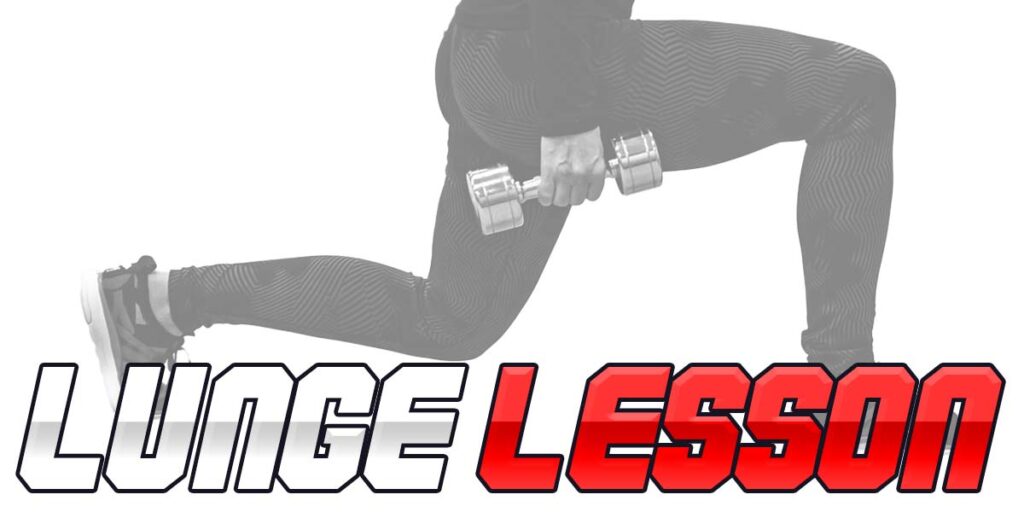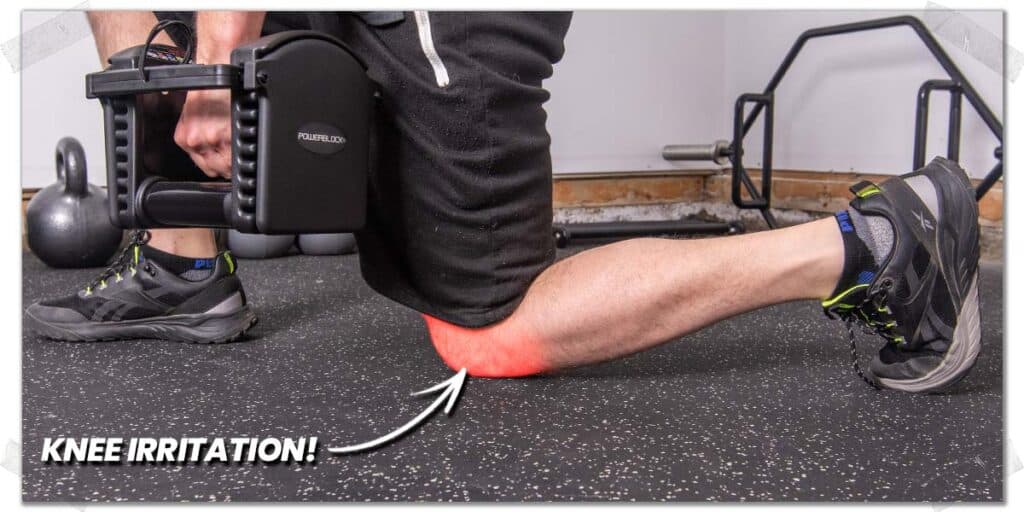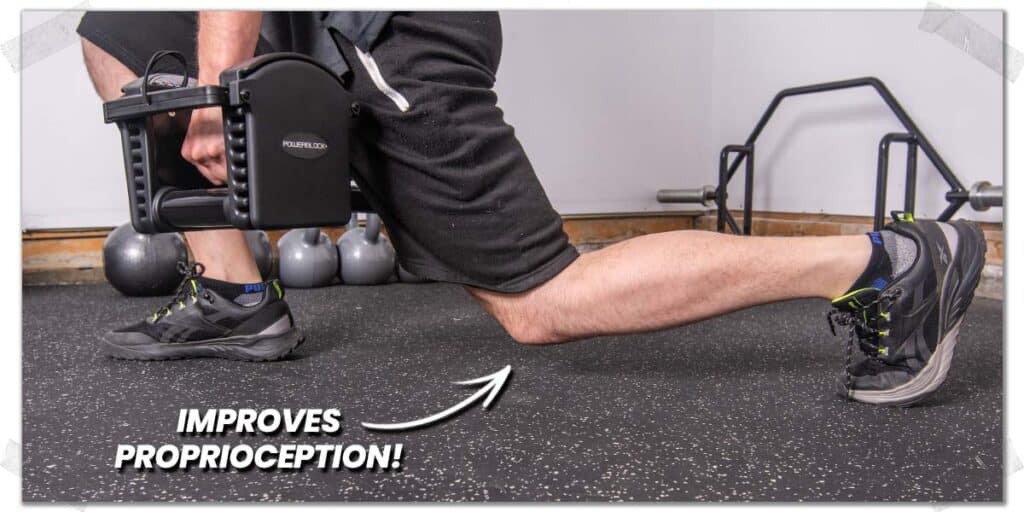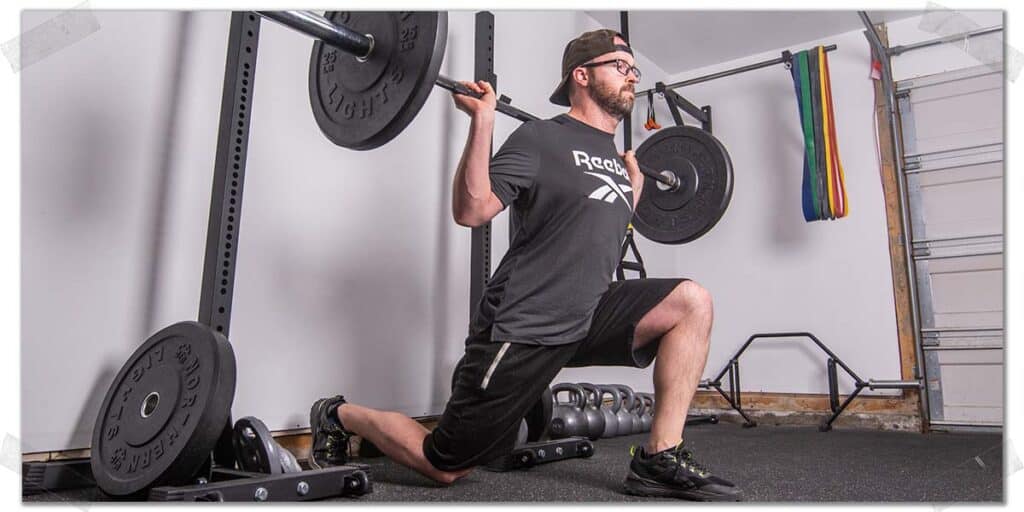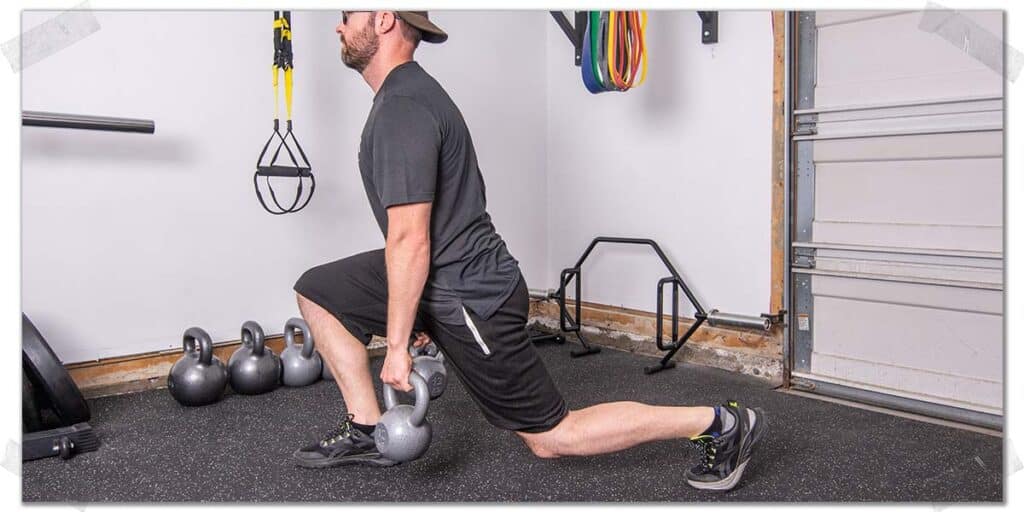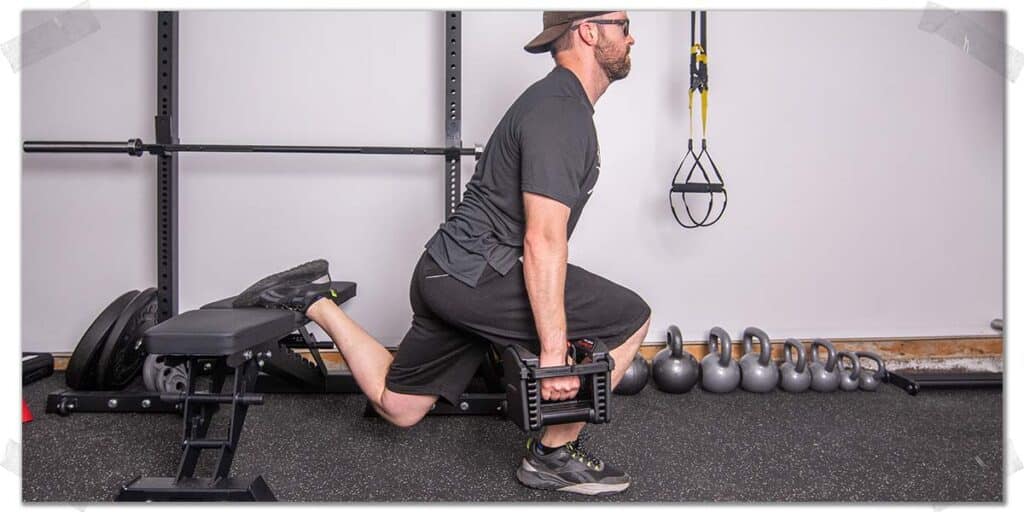There’s a reason why lunges are one of the most popular lower body exercises in the world of fitness and strength training: they work. Lunges can be performed in a variety of ways and are immensely effective for building muscular strength and endurance within your lower body. One common question I commonly see online is whether the knee should touch the ground when performing lunges.
Knowing the answer to this question can take your training and performance to new levels, so as we dive into this article, here’s your one-sentence answer:
While there’s nothing inherently wrong with lightly tapping your knee on the ground when lunging, keeping your knee slightly off the floor at the bottom of the lunge will help avoid knee irritation, enhance proprioception, balance, and ensure continual loading of the leg during the exercise.
Assuming you want to learn when, how, and why you should AND shouldn’t tap your knee on the ground when lunging, keep on reading (I’ll be sharing some information that just might surprise you).
Related article: Nine Ways to Make Lunges WAY Harder Without Adding Any Weight
As we dive into this lunge lesson, it’s important to understand that it’s neither universally right nor wrong to have your knee make contact with the floor when you lunge. There can, in fact, be benefits to either.
That being said, I believe the average individual has more reason and benefit to gain from having their knee stay off the ground at all times than making contact (you’ll understand why as you keep reading).
Additionally, striving to get the knee as close to the floor as possible without making contact should be the goal of an otherwise healthy individual (i.e., someone who doesn’t have knee, hip, or back issues, etc.).
Nonetheless, let’s dive into the world of reasons for when and why lunges should and shouldn’t involve knee-to-ground contact.
A small request: If you find this article to be helpful, or you appreciate any of the content on my site, please consider sharing it on social media and with your friends to help spread the word—it’s truly appreciated!
No contact: reasons not to touch your knee to the ground
Since I’m of the belief that the average individual will get more benefit from their lunges by keeping their knee in a hovering state, we might as well start here. These are some compelling reasons that can lead to improved knee health, performance, and overall leg strength and endurance.
Reason 1: avoiding knee irritation
This is, of course, the most obvious reason for avoiding knee contact with the ground during the lunge (don’t worry; the following reasons are much more exciting and less obvious).
Still, it should go without saying that slamming your kneecap into the ground can lead to all sorts of patellar (kneecap) irritation, particularly if you’re forcefully dropping your knee onto the ground rep after rep.
Pro tip: For those who would like their knee to contact the ground, try to keep the contact as light as possible, barely grazing the floor. Descending slowly into the lunge is also recommended since it helps avoid any sudden, jarring contact of the patella with the ground.
If nothing else, it’s worth ensuring you don’t mindlessly drop your knee to the floor and slam it onto the ground when lunging; it might not hurt at the moment but do enough repetitions like this throughout your training program and you just might find your knees becoming sore, achy, or painful. This, in turn, will mess with your ability to lunge or perform other lower-body exercises. No bueno.
Alright, the boring stuff is over. Onto the next reason!
Reason 2: Improving proprioception of the knee and lower body
Proprioception refers to the brain’s ability to interpret and feel the positioning of our joints and limbs. If you were to close your eyes and touch the tip of your index finger to your nose, you’d notice that you don’t require visual input to do so; your brain is using the proprioceptors within your joints and limbs to successfully guide your finger to its intended target.
The same phenomenon occurs when guiding your knee down to the floor; you’re using proprioception to complete the task, and guess what?
Practicing guiding your knee as close to the floor as possible when lunging without making contact will enhance your proprioception within your knee. This enhanced proprioception can lead to reduced injury potential that can otherwise occur when poor proprioception of the knee is present.
The goal here is to become as confident as possible in knowing how close or far your knee is from the floor at all times. In other words: you want to be able to feel where your knee is at all times in relation to the ground.
How to practice improving proprioception within your knee
The easiest way to improve knee proprioception is to perform bodyweight split lunges (i.e., remove the stepping portion of the lunge and don’t hold onto any extra weight). This involves slowly lowering your back knee to the floor and stopping the downward movement once you feel you’re within an inch of the floor.
Once you believe to be an inch away from the floor, hold this position for a second, then slowly lower your knee down a bit more. If you’re within an inch or so, you should make light contact with the ground almost immediately when resuming the downward movement.
If you notice that your knee had to drop down more than you thought it might need to, you were likely more than an inch off the floor, meaning your proprioceptive accuracy wasn’t great for that repetition.
Keep practicing this drill (with both knees) until you can repeatedly and confidently hold your knee around an inch off the floor when dropping down into your lunge.
Pro tip: You can place a yoga mat or thin pad beneath your knee if you want to avoid having your knee contact the hard floor or surface you’re practicing on.
Reason 3: Improved balance and movement control
Even a small, momentary duration of knee contact on the floor can correct and restore your balance when you’re halfway through your lunge. Don’t get me wrong; balance and control during lunging exercises are important. Rather, what I’m saying is that the goal of your lunge should be to exhibit movement control and balance throughout all points of the lunge as opposed to needing to make ground contact with your knee to help provide positioning correction and input halfway through the movement.
Pro tip: a significant portion of this balance and movement control comes from having adequate proprioception within the knee and lower body. So, if your proprioception is poor, you can enhance your balance and movement by cleaning up your proprioception (see reason 2 above).
If you’re keeping your knee off the floor when lunging and find yourself a bit wobbly, this can be a good thing, as it signifies you’re challenging your body’s balance systems. The key here is to fight for balance and control while still being able to complete your lunges in a controlled manner.
Remember: strength and endurance within your legs don’t mean much if you don’t have the ability to produce adequate balance and movement control when using them!
“If nothing else, it’s worth ensuring you don’t mindlessly drop your knee to the floor and slam it onto the ground when lunging; it might not hurt at the moment but do enough repetitions like this throughout your training program and you just might find your knees becoming sore, achy, or painful.”
Reason 4: Continual loading of your leg muscles
If you’re someone who likes to put a fair amount of weight through your knee onto the floor or you’re someone who keeps their knee on the floor for a second or more when at the bottom of your lunge, you might be missing out on some additional muscle-strengthening benefits you’d otherwise be incurring.
Granted, I don’t know many people who take a prolonged rest with their knee on the floor when performing traditional lunges, but I suppose there are some out there who might do this, particularly when their legs are becoming tired throughout the exercise.
Even a small or short break taken during the lunge by placing the knee on the floor can reduce the overall demand of the exercise, reducing the effectiveness of the movement from a strength and endurance perspective.
Caveat: Forcefully driving out of a long pause (greater than a couple of seconds) at the bottom of the lunge can actually place an intense demand on the leg muscles, which can be rather advantageous for producing raw, contractile strength within the leg muscles (this will be covered more later within the article).
The average fitness-goer doesn’t perform lunges in this manner, however (it tends to be an advanced training strategy), so in this section of the article, I’m opting for the average individual to keep their leg loaded at all times (i.e., knee off the ground) throughout the lunge. Again, there are times when it will be warranted, so keep reading if you want to know more.
If you do opt for this knee-contact strategy, be sure to use a padded surface to rest your knee on to avoid any irritation that may arise from prolonged contact time with the ground.
When you keep your knee off the floor during your lunge, your leg muscles (your gluteal muscles, quadriceps, hamstrings, and even a portion of your adductors) must stay contracted (i.e., loaded) at all times. This, in turn, creates more mechanical work or stress the muscles must endure (this is a good thing).
The more stress your leg muscles endure, the more tired or fatigued they become. The more fatigued they become, the more they adapt in terms of strength and endurance. This means you’re getting more out of your lower body exercise. Short-lived breaks disrupt this continual state of muscle tension, which can lessen the workload, limiting the adaptations you’re hoping to make in terms of muscle strength and endurance.
So, long story short: keeping your knee off the ground during your lunge can help you get more out of the exercise!
Related content:
Contact: when touching your knee to the ground is warranted
As mentioned at the start of this article, there can certainly be times when knee contact (either light and brief or prolonged) can be warranted. Like anything else, it’s all in the details and depends on one’s circumstances, training goals, and other individual needs.
So, let’s look at the scenarios where it might be a wise move to put your knee on the ground when performing an exercise such as the traditional lunge.
Reason 1: Enhancing hip and thigh mobility
For an otherwise healthy set of knees, hips, and back, dropping down low enough into your lunge to have your back knee gently tap the floor can be a smart move to make if you’re looking to challenge (or maintain) your hip and quadriceps mobility.
The deeper you drop into your lunge, the more the muscles on your anterior (front) hip and thigh must lengthen to accommodate the increased range of motion.
Now, this is predicated on your ability to keep your torso fairly upright at all times (i.e., keeping your lower back straight and chest facing forwards). If you let your lower back round or point your chest towards the floor, it will negate the extent of lengthening these muscles must undergo.
Related article: Here’s Why Your Hips Ache After Working Out (And What to Do About It)
Additionally, the greater the distance away your front foot is from your back foot, the more challenging it will be to lower your back knee to the ground.
So, if you want to maintain (or improve) the mobility along the front side of your hip and leg and are capable of gently tapping your knee on the floor when lunging, you’ll ensure you’re lengthening out these respective muscles as much as possible during the movement.
Pro tip: If you want to truly maximize the mobility of this area of your lower extremity while strengthening the same muscles as with a traditional lunge, the Bulgarian split squat is your best bet!
Who benefits from this technique?
Dropping down as deep as possible (without sacrificing your overall mechanics) can be ideal for those who want to maximize their anterior hip and thigh mobility while building strength and endurance throughout their legs. It’s, therefore, ideal for those who feel they receive an adequate stretch to this region without experiencing any pain in the process.
Reason 2: Long pauses for raw strength
I briefly mentioned this concept earlier in the article, but now we’ll dive into a more detailed explanation. The rationale (and benefit) for taking an extended pause during a lunge is to eliminate muscle preload.
Muscle preload refers to the natural recoil that muscles exhibit when lengthened out, causing them to “spring” back to a shorter length. It’s dictated by two different mechanisms within the body:
- The series elastic component (SES) (the natural elastic properties of the muscle and tendon).
- The stretch-shortening cycle (SSC), which is a reflexive activity that arises within the muscle when it detects a sudden stretch.
Ultimately, these two factors that cause muscle preload can make a movement a bit easier to perform (so the muscles don’t have to work as hard). A long pause (greater than a second or two) can eliminate this natural recoil, forcing the muscles themselves to contract more forcefully to complete a movement.
As a result, rising out of a knee-on-ground lunge can place more working effort into the gluteal, quadriceps, and adductor muscles (particularly the adductor longus).
Pro tip: To eliminate as much muscle load as possible, you’ll want to rest enough weight on your knee to take all muscle tension off your front leg. Since you’ll therefore be placing a fair amount of weight on your knee, use a padded surface between the ground and your knee to avoid any discomfort or pain on your kneecap.
As you try to drive yourself out of this position, you’ll notice that it’s much more challenging to do so than when dropping down into the lunge and, thereafter, instantly returning to the starting position.
Who benefits from this technique?
This preload-eliminated lunge tends to be more appropriate for those who already have adequate lower body strength, can perform traditional lunges with ideal technique, and for those who want to focus on maximizing muscle contraction during their lunges.
It can also be ideal for those who want to make their lunges harder without holding onto heavier resistance loads. (Since eliminating muscle preload is more challenging for the muscles, lifters will need to use less weight than with the traditional lunge.)
Final thoughts
For the average fitness-goer, it’s probably best to let the knee go as close to the floor as possible during the lunge without making contact. This method of lunging has numerous benefits that will help enhance strength, endurance, balance, mobility, and proprioception for the individual.
There are benefits to having your knee contact the ground when lunging, though they tend to be for reasons that more advanced or experienced individuals use.
Ultimately, neither way is right or wrong. Still, for the average individual, I’d advocate keeping their lunges slow and controlled while keeping the knee off the ground at all times.
Frequently Asked Questions
In addition to what I’ve written within this article, I’ve also included a few brief answers to other questions individuals often have regarding lunges and lunging!

Hi! I’m Jim Wittstrom, PT, DPT, CSCS, Pn1.
I am a physical therapist who is passionate about all things pertaining to strength & conditioning, human movement, injury prevention and rehabilitation. I created StrengthResurgence.com in order to help others become stronger and healthier. I also love helping aspiring students and therapists fulfill their dreams of becoming successful in school and within their clinical PT practice. Thanks for checking out my site!


